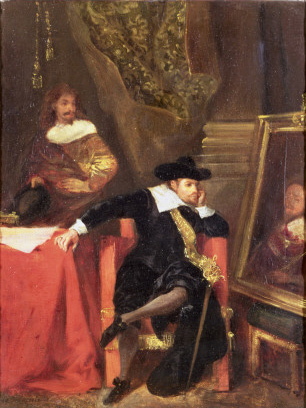Cromwell at Windsor Castle is an oil painting by the French artist Eugène Delacroix.
Delacroix lived between 1798 and 1863, over 150 years after the English Civil Wars, i.e. the subject matter of this painting.
During the English Civil Wars in the mid seventeenth century, Oliver Cromwell (who was the leader of the Parliamentarian army which was fighting against Charles I) used Windsor castle as his headquarters.
He also used it as a prison. Delacroix depicts Cromwell in what seems to be a pensive mood. Look to the right of the painting and we can see that Cromwell is contemplating a painting of his rival, Charles I.
It may be said, then, that Delacroix's painting is attempting to encapsulate the rivalry between Charles I and Oliver Cromwell that was in many ways at the heart of the Civil Wars in England.
This painting is in a style that is typical of Delacroix's work: a realistic use of oils that helps to convey the personality and the emotions of a human subject. This is not the only painting by Delacroix with an English theme, either.
For example, another famous picture by this artist is Hamlet and Horatio in the Graveyard. This painting depicts a scene from the play Hamlet by William Shakespeare (1599). However, unlike the painting of Hamlet and Horatio, Cromwell at Windsor Castle purports to depict a historical personage, and to give an insight into events that really did happen rather than the fictional events of a play.
Some commentators have wondered about the figure behind Cromwell in the painting. Is it Charles I himself? Is it his ghost? Or, perhaps it is Charles II, Charles I's son. Either way, Cromwell is so absorbed in contemplating the painting of Charles that he does not seem to register the presence of this figure behind him.
Perhaps, this painting has a moral: that Cromwell is ignoring something very important. If it is Charles II, for instance, with the wisdom of hindsight, Delacroix could be suggesting that Cromwell is being watched over by the figure of the future king and that Cromwell's victory was thus something impermanent.




